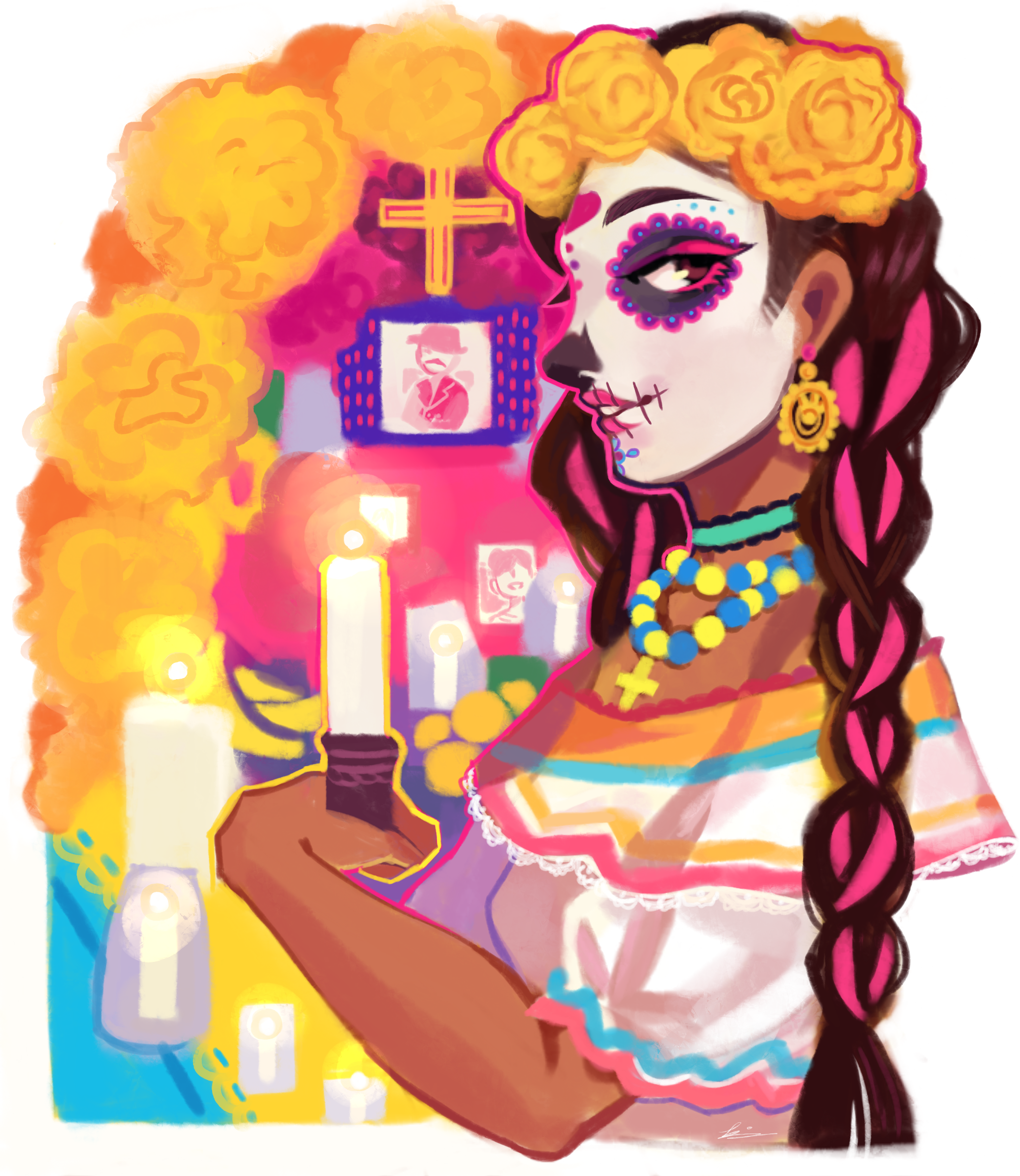Dia de los Muertos celebrations bring ancestors, traditions back to life

(QingQing Su/Daily Bruin)
By Jordan Dakin
Nov. 1, 2016 12:00 a.m.
Melted candles, painted sugar skulls, bright marigolds, delicious pastries and photos line a brightly colored tablecloth. A traditional Dia de los Muertos altar tells a story and captures the memories of those who have passed.
Dia de los Muertos (Day of the Dead) is traditionally celebrated in Mexico on Nov. 1 and 2.
At UCLA, the centuries-old traditions are celebrated through individual student efforts, student organizations and school-sponsored events on the Hill and across campus. Local students also celebrate exclusively with their families at home, while for others, the commercial popularity of the holiday has inspired them to learn more about it.
[Related: The Quad: Celebrating cultural holidays in the fall at UCLA]
Audrey Harris, an assistant adjunct professor in the Department of Spanish & Portuguese, sets aside room in her curriculum for Dia de los Muertos.
“I like the celebratory elements of (Dia de los Muertos) and the idea of the dead living among us, all around us,” Harris said. “It’s a different view of death than we have (in the United States), different from the Christian view of death.”
During instruction in November, Harris plays her students the song “Hasta Morir” by Caifanes because she appreciates the narrative and feels it’s important to interpret death positively, she said.
Dia de los Muertos is popular to some because of the style, the overwhelming presence of skulls and its relation to Halloween, said Josephine Diaz, a fourth-year psychology student. Since she’s a third-generation Mexican-American, her family has never celebrated the holiday, but she would like to learn more about it, Diaz said.
Laura Rios’ family in Los Angeles celebrates by making and displaying favorite foods of loved ones on a homemade altar, said the fourth-year political science student. She said they present the food for ancestors to come and symbolically eat next to the family.
Maria Amaya has always understood the importance of celebrating her ancestors, even after she moved here from Mexico with her family eight years ago, said the second-year international development studies student. Her mother continues to have flowers sent to the graves of loved ones back in Mexico to make sure ancestors never feel forgotten, she said.
“It’s a nice way to commemorate lost loved ones,” Amaya said.
Amaya’s family in Los Angeles also makes ofrendas (altars) and displays marigolds and the favorite foods of their deceased loved ones as they did while living in Mexico, she said. While Amaya does not create altars while she is at UCLA, her family keeps lost loved ones in mind by indulging in eating the traditional treat pan de muerto (bread of the dead), she said.
Jocelyn Pérez, a fourth-year psychology student, said it wasn’t until coming to UCLA that she felt the need to partake in Day of the Dead celebrations. Her immediate family never celebrated the holiday, but she learned about some traditions, such as altar-building and cemetery parties, because her grandmother attended cemetery celebrations in Mexico.
Upon coming to UCLA, Pérez was introduced to Grupo Folklórico de UCLA, an organization that unites students through regional dance and encourages a deeper understanding of Mexican culture.
Pérez now celebrates Dia de los Muertos as a member of Grupo Folklórico.
“I didn’t really know that people celebrated (Dia de los Muertos) in the U.S. until I came here,” Pérez said. “I found a culture (at UCLA) through this group.”
Pérez realized her love of dance and her desire to celebrate her loved ones who had passed through participating in performances, she said.
“My perception has totally changed because you learn about it and you ask yourself, ‘Why wouldn’t I celebrate this?’” Perez said.
[Related: Grupo Folklórico de UCLA to perform annual cultural showcase]

At “Dia de los Muertos on the Hill” on Sunday, Grupo Folklórico performed traditional dances from Mexican regions such as Veracruz, Sinaloa and Nuevo León to honor lost loved ones. Students ate black beans and rice, painted sugar skulls, painted their faces and created their own papel picado, Mexican folk art made out of paper cut into decorative designs.
The group will hold its Dia de los Muertos dance show on Nov. 11.
Fourth-year sociology student Esmeralda Magaña, who has been a part of Grupo Folklórico since her freshman year, said the increased interest in baila folklórica (folklore dance) is in part due to the influx of immigrants coming into America. More UCLA students have shown interest in dancing for Grupo Folklórico and learning more about Dia de los Muertos, Magaña said.
The holiday attracts students because they can share in music, dancing, drinking and food, Magaña said.
“Usually when death comes, it’s very saddening and dark … (Dia de los Muertos) is just a celebration of life,” Magaña said. “There is a family aspect to it and that is my favorite part.”


